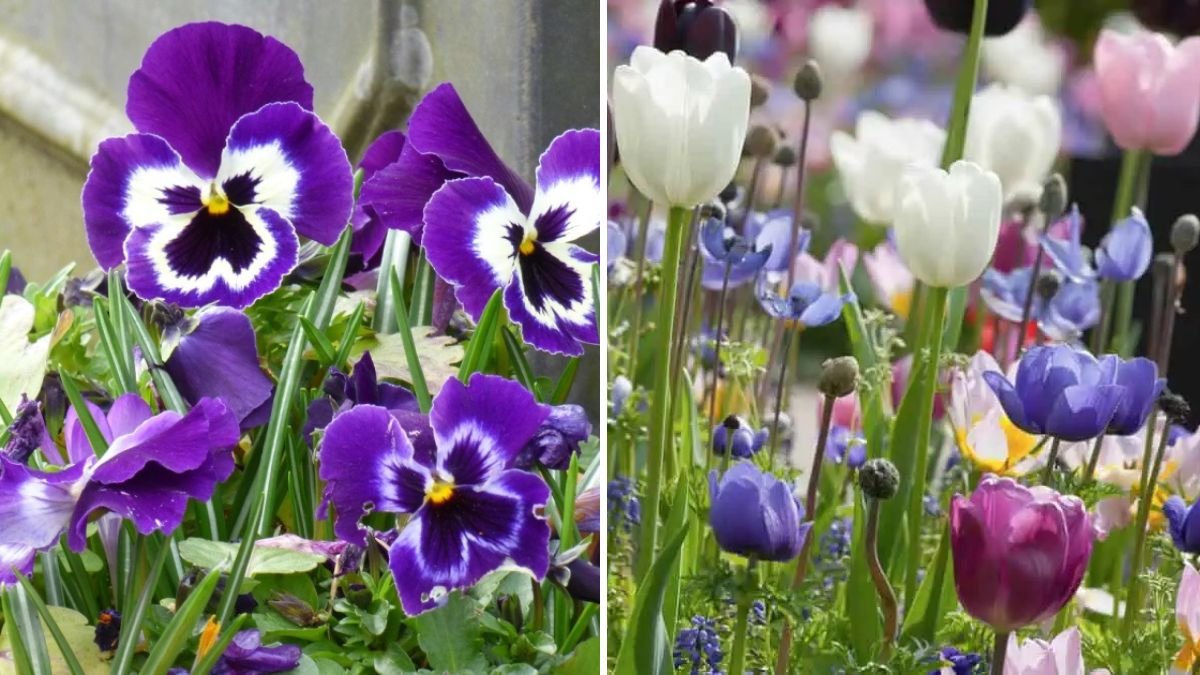Tulips (Tulipa spp.) are iconic spring flowers, celebrated for their vibrant colors, elegant shapes, and early-season charm. Whether planted in garden beds, borders, or containers, tulips bring a burst of life after the winter months. However, their beauty and growth potential are enhanced when paired with complementary companion plants. Properly chosen companions can extend the bloom season, attract pollinators, improve soil health, and enhance visual appeal.
In this article, we’ll explore five flowers that make perfect companions for tulips, explain why they pair well, and provide practical tips for creating a thriving spring garden.
Why Companion Planting Enhances Tulips
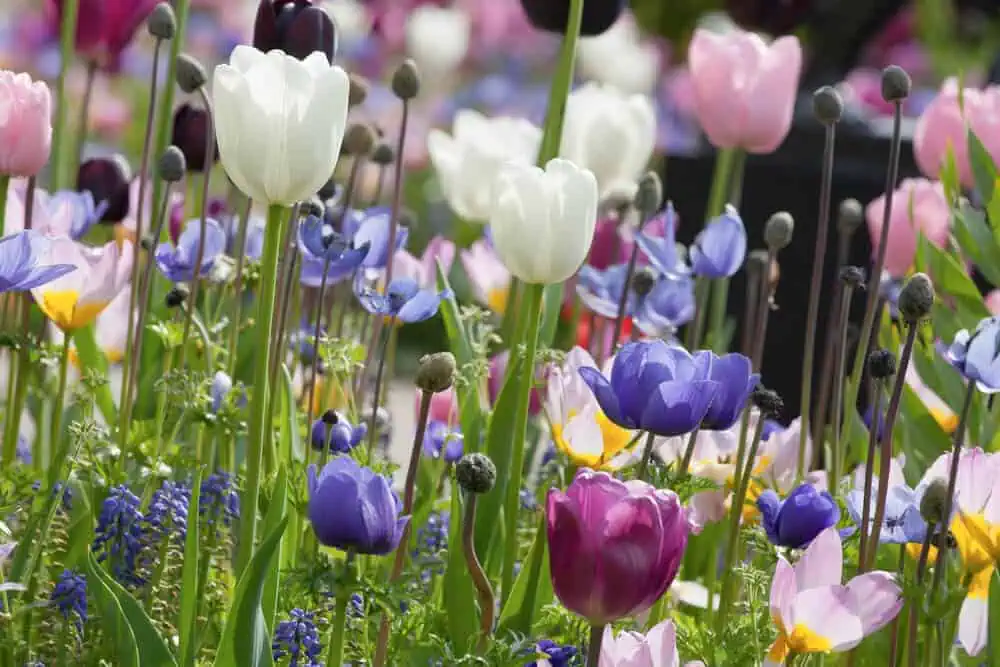
Companion planting is the practice of strategically placing plants together for mutual benefit. For tulips, it can:
- Protect from pests and diseases naturally
- Provide structural support or aesthetic contrast
- Extend flowering periods by pairing with early or late bloomers
- Improve soil conditions through complementary root systems
Tulips prefer well-drained soil, full to partial sun, and moderate watering, so the best companions share these growing requirements.
1. Daffodils (Narcissus spp.)
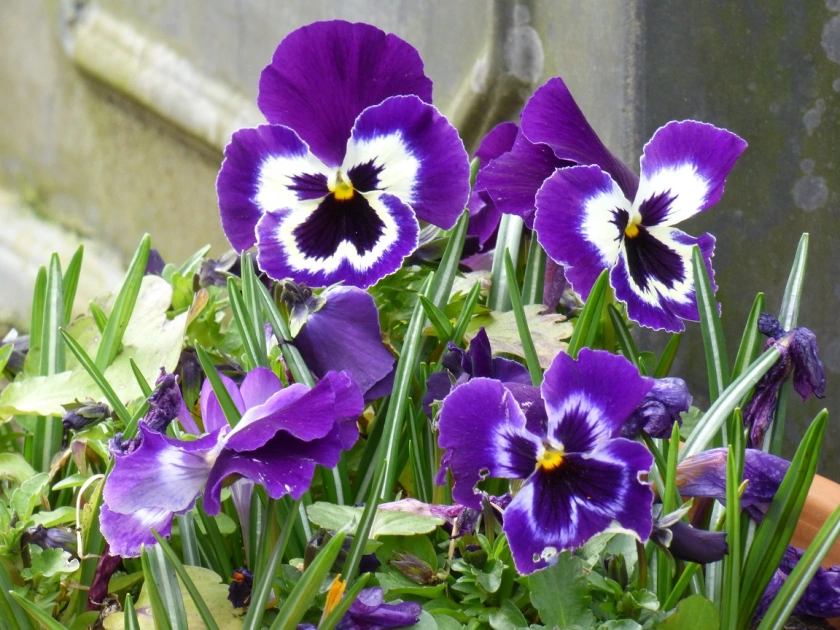
Daffodils are classic companions for tulips, creating springtime color harmony and offering functional benefits.
Why They Work Well Together:
- Both bloom in early spring, producing a coordinated burst of color.
- Daffodils’ foliage helps hide dying tulip leaves after bloom, maintaining garden tidiness.
- Daffodils are deer-resistant and pest-deterrent, protecting tulips from rodents and other nibblers.
Planting Tips:
- Plant daffodil bulbs 2–4 inches apart around tulip clusters.
- Use dwarf or medium-sized daffodils to avoid overshadowing tulip blooms.
- Mix colors carefully to create a visually appealing spring palette.
Expert Insight: Combining tulips with daffodils creates layered interest and continuous garden appeal, even as some blooms fade earlier than others.
2. Hyacinths (Hyacinthus spp.)
Hyacinths add fragrance and texture, making them perfect companions for tulips.
Why They Work Well Together:
- Both bloom in spring and prefer full sun to partial shade with well-drained soil.
- Hyacinths’ compact, fragrant blooms complement tulips’ tall stems and bold colors.
- Attract pollinators like bees, enhancing the health and vigor of all garden plants.
Planting Tips:
- Plant hyacinth bulbs 4–6 inches apart between tulip clusters to fill gaps.
- Choose contrasting colors for visual impact or harmonious shades for a subtle look.
- Mulch lightly to retain moisture and protect bulbs during early spring.
Expert Insight: Hyacinths’ strong fragrance enhances the sensory experience of tulip gardens, making them ideal for entrances, walkways, and container arrangements.
3. Pansies (Viola tricolor var. hortensis)
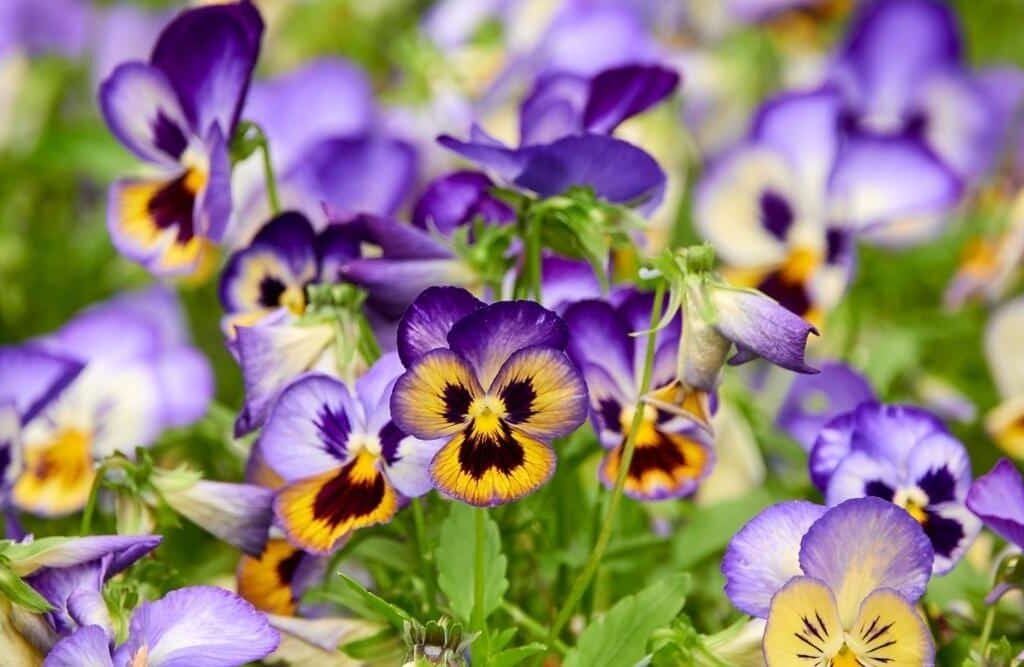
Pansies are charming, low-growing flowers that provide a carpet of color beneath tulips.
Why They Work Well Together:
- Their compact growth habit does not compete with taller tulips for sunlight.
- Pansies tolerate cool temperatures, blooming early alongside tulips.
- The colorful blooms create a striking contrast to tulips’ upright stems and bold petals.
Planting Tips:
- Plant pansies around the base of tulip bulbs, maintaining spacing for airflow.
- Choose shades that complement or contrast tulip colors to enhance garden design.
- Deadhead spent flowers to encourage longer bloom and maintain neat appearance.
Expert Insight: Pansies and tulips together provide multi-layered spring interest, extending color coverage at the ground level while tulips dominate vertical space.
4. Forget-Me-Nots (Myosotis spp.)
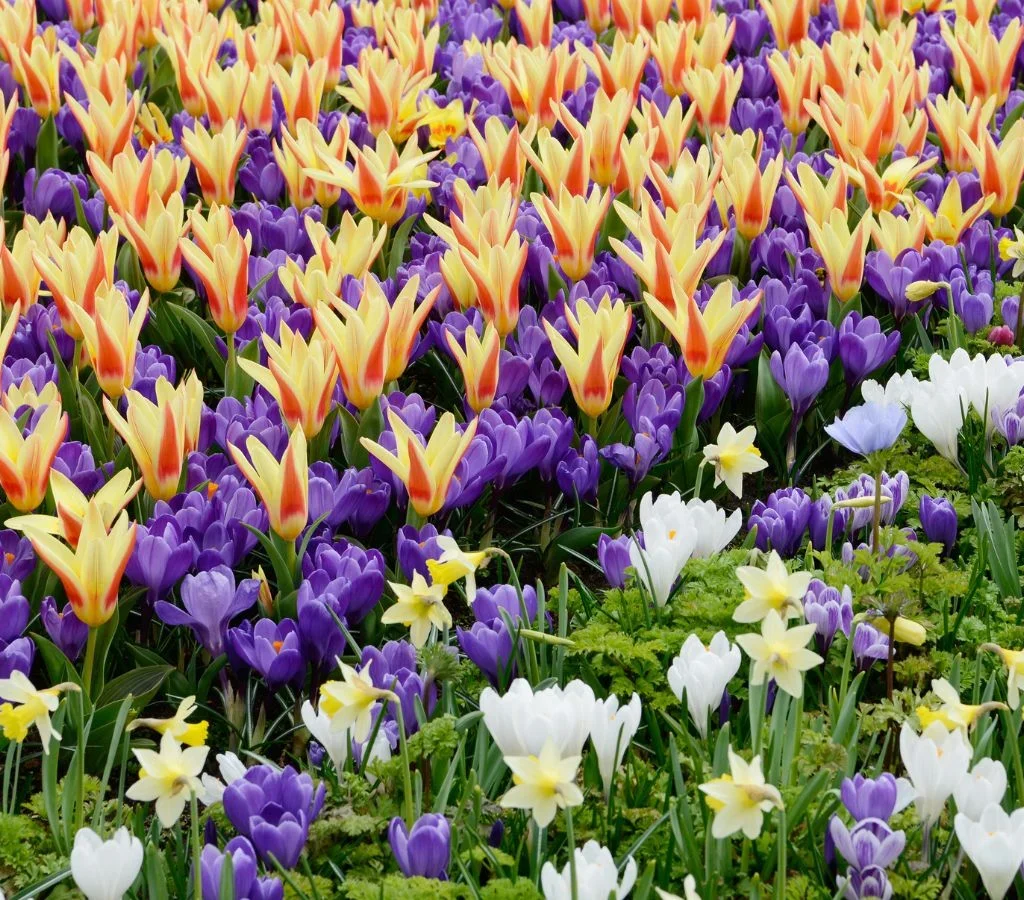
Forget-me-nots are delicate, low-growing perennials with sky-blue flowers that beautifully complement tulip beds.
Why They Work Well Together:
- They bloom slightly after tulips, extending the visual interest of spring gardens.
- Low-growing foliage and flowers fill in gaps around tulip stems, creating a lush carpet effect.
- Attract pollinators and provide groundcover that helps retain soil moisture.
Planting Tips:
- Sow seeds or plant seedlings around tulip beds in fall or early spring.
- Space plants 6–8 inches apart to allow spreading without crowding tulip bulbs.
- Maintain moderate watering while tulips are dormant to support forget-me-not growth.
Expert Insight: The soft, pastel colors of forget-me-nots contrast beautifully with bold tulip colors, creating romantic and natural-looking spring displays.
5. Alliums (Allium spp.)
Alliums, or ornamental onions, are tall, striking blooms that pair well with tulips for height, texture, and pest control.
Why They Work Well Together:
- Both bloom in spring, with alliums often appearing slightly later to extend flowering periods.
- Tall, spherical blooms of alliums provide architectural interest and complement tulip shapes.
- Alliums’ natural sulfur compounds repel pests like aphids and rodents, protecting tulips.
Planting Tips:
- Plant allium bulbs 6–8 inches apart among tulip clusters.
- Select mid-sized or dwarf alliums for smaller gardens or container arrangements.
- Ensure sufficient spacing to prevent shading tulip blooms.
Expert Insight: Alliums bring vertical drama and natural pest protection, making them a functional and decorative companion for tulips.
Tips for Designing a Tulip Companion Garden
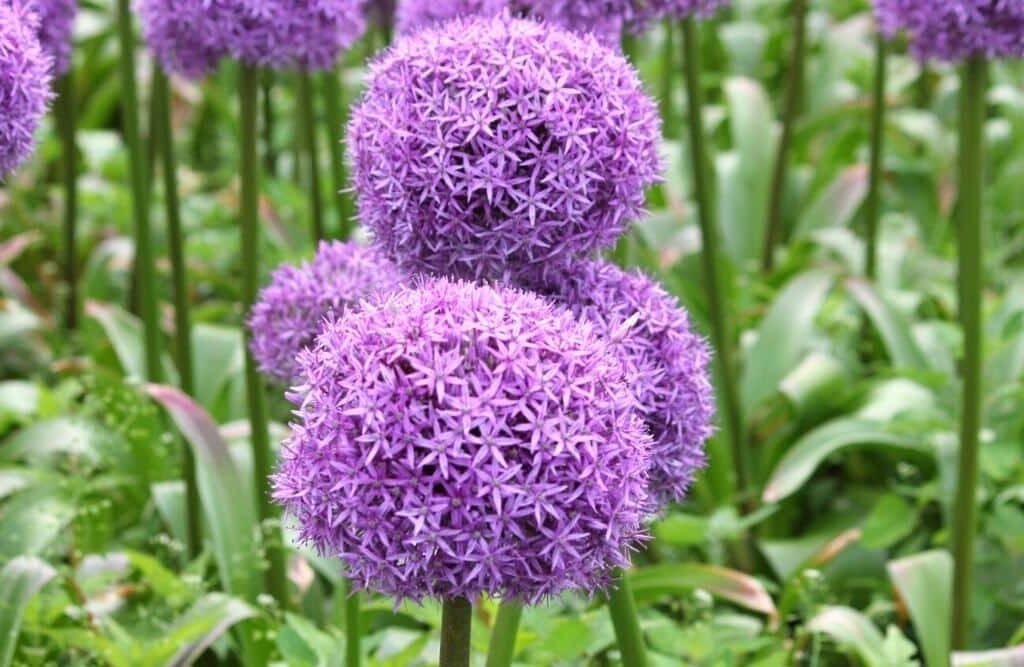
- Sunlight: Ensure all companion plants receive 6–8 hours of sun to thrive alongside tulips.
- Soil: Use well-draining soil with moderate fertility. Avoid overly rich soil that may produce lush foliage at the expense of blooms.
- Watering: Tulips and companions like daffodils, pansies, and alliums prefer moderate watering, avoiding soggy conditions.
- Spacing: Proper spacing ensures airflow and prevents fungal diseases.
- Staggered Blooming: Combine early, mid, and late bloomers for continuous color through spring.
- Mulching: Apply light mulch to retain moisture, regulate soil temperature, and protect bulbs during dormancy.
Benefits of Companion Planting with Tulips
- Extended Blooming Season: Companion plants fill in before, during, and after tulip flowering.
- Enhanced Garden Beauty: Layered heights, textures, and colors create visually dynamic displays.
- Natural Pest Management: Certain companions repel pests and attract beneficial insects.
- Low Maintenance: Combining drought-tolerant or similar-growth plants reduces care requirements.
- Soil Protection: Ground-covering companions like pansies or forget-me-nots reduce erosion and retain moisture.
Conclusion
Tulips are a centerpiece of spring gardens, but their full potential is realized when paired with the right companions. Daffodils, hyacinths, pansies, forget-me-nots, and alliums provide color, texture, pest protection, and extended bloom times, creating vibrant and resilient garden beds.
By strategically planting these companions with tulips, gardeners can enjoy a continuous display of color, fragrance, and visual interest, while reducing maintenance and protecting plants naturally. Whether in garden beds, borders, or containers, these five companion flowers ensure that tulip gardens are both beautiful and thriving, offering a season-long celebration of spring.
